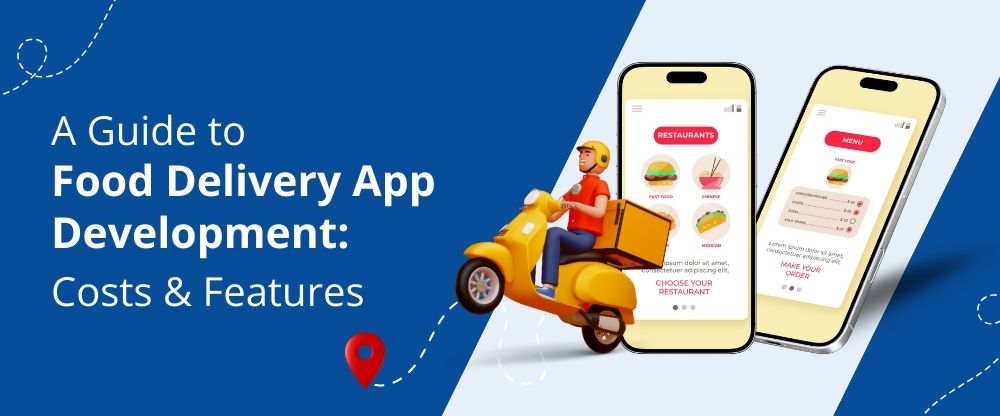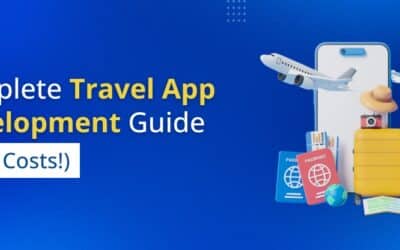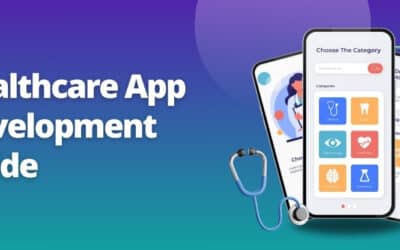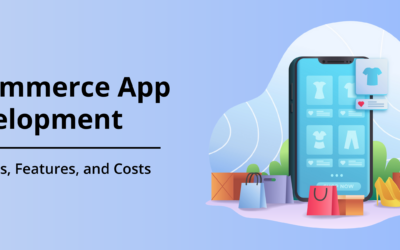Summary of the Article
Have a project in mind?
Schedule a CallA Guide to Food Delivery App Development: Costs & Features
Summary of the Article
What if I told you that ordering food has become as effortless as scrolling through your phone? Sounds familiar, right? Food delivery apps have seamlessly blended into our daily lives, turning cravings into convenience with just a few taps. Whether it’s a late-night snack or a family dinner, these apps deliver it all, anytime, anywhere.
It’s no surprise that the industry is thriving. The global food delivery market is projected to reach $320 billion by 2029, growing at a steady CAGR of 10.5%. Companies like DoorDash and Uber Eats have cracked the code with innovative business models and seamless user experiences, proving that the right strategy can turn a basic idea into a billion-dollar success.
Let’s take DoorDash, for example. This food delivery startup targeted underserved suburban areas and mastered logistics; they now dominate over 50% of the U.S. food delivery market, delivering more than 1 billion orders annually. Their journey shows that success in this space requires more than just great technology—it’s about building a business model that’s scalable, profitable, and customer-centric.
If you’re planning to step into this booming industry, partnering with the right food delivery app development company is the first step. From conceptualizing the business model to crafting an app with user-friendly features, expert food delivery app development services are key to staying competitive.
In this guide, we’ll explore the strategies behind successful food delivery apps, reveal how companies like DoorDash made it big, and share insights on creating your own app. Whether you’re looking to expand your offerings or start fresh, this blog will show you how Mobile App Development Services can help turn your vision into reality. Let’s get started!
What is a Food Delivery App Business Model?
A food delivery app business model is the backbone of how a food delivery app operates and generates revenue. It acts as a framework that brings together customers, restaurants, and delivery partners in a seamless and efficient way. From placing an order to tracking it in real-time, the business model defines how the entire process works.
A strong business model goes beyond just functionality. It ensures scalability, enabling the app to handle a growing number of users, expand into new markets, and maintain quality service. It also lays the foundation for sustainable revenue streams by aligning the needs of all stakeholders.
Whether it’s streamlining logistics, optimizing operations, or enhancing the user experience, a well-designed business model is essential for success in this competitive industry. With the right approach, food delivery apps can meet evolving customer demands and stand out in the market.
Types of Food Delivery App Business Models
Every food delivery app operates on a business model that defines how it serves customers and generates revenue. But here’s the exciting part—there’s no one-size-fits-all! From digital marketplaces to fully managed logistics systems, each model offers a unique way to thrive in the market. Let’s break down the most popular ones in simple terms:
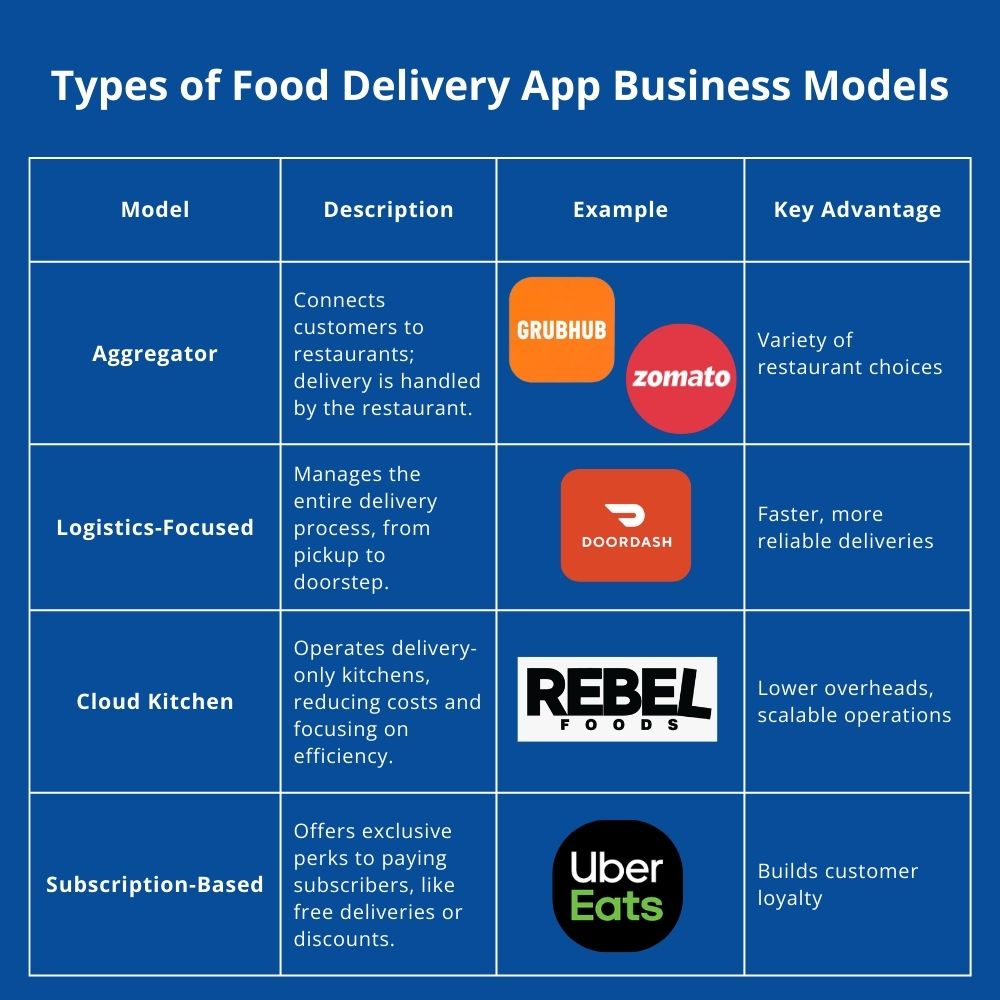
Pro Tip: When choosing a business model, consider your target market, resources, and operational goals.
Aggregator Model
Think of the aggregator model as a digital food court. These platforms list various restaurants, letting customers explore menus, place orders, and pay seamlessly. The twist? Restaurants handle their own deliveries, while the app earns a commission on every order.
Apps like Grubhub and Zomato are prime examples. They give users endless dining options without worrying about managing deliveries. It’s a win-win for customers looking for variety and restaurants aiming to expand their reach.
Logistics-Focused Model
Now, this one’s all about control. In the logistics-focused model, the app doesn’t just connect restaurants with customers—it takes charge of the entire delivery process. From picking up orders to ensuring they arrive hot and fresh, the app manages it all.
Take DoorDash, for example. By investing in its own fleet of delivery drivers, it guarantees fast and reliable deliveries. This level of control is a game-changer, especially for ensuring top-notch customer experiences.
Cloud Kitchen Model
Imagine a restaurant that exists solely in the digital world. No dine-in area, no fancy décor—just a kitchen focused entirely on preparing meals for delivery. That’s the cloud kitchen model, and it’s taking the food industry by storm.
In 2023 alone, cloud kitchens generated over $43 billion globally, proving their potential. Companies like Rebel Foods have mastered this model, cutting costs while maximizing delivery efficiency. For businesses looking to prioritize affordability and scale, this is a fantastic option.
Subscription-Based Model
Who doesn’t love perks? The subscription-based model offers exclusive benefits to loyal customers in exchange for a small fee. Think free deliveries, special discounts, or early access to deals.
Uber Eats Pass does this exceptionally well. Subscribers spend 50% more annually than regular users, making it a lucrative strategy for building customer loyalty and generating consistent revenue.
As we move forward with learning the business models, we must look at the real success story that blew everyone’s mind.
How DoorDash Went from Startup to Billion-Dollar Success
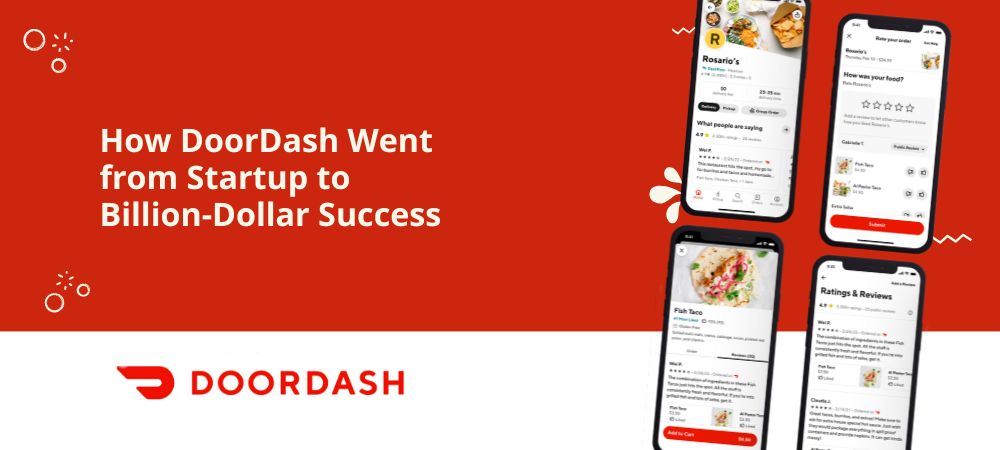
When it comes to conquering the food delivery market, few names shine as brightly as DoorDash. Its journey from a small startup to a market leader offers invaluable insights for aspiring entrepreneurs. Let’s unpack their incredible success story and uncover what makes their business model a blueprint for success.
How It All Began
In 2013, four Stanford students launched DoorDash with a clear mission: to bring food delivery to areas that others ignored. Suburban neighborhoods, often overlooked by big players, became their primary focus. This hyper-local strategy helped them stand out and gain a loyal customer base.
Key Ingredients to DoorDash’s Success
Efficient Delivery Logistics
DoorDash built its foundation on streamlined delivery operations, ensuring food arrives fast and fresh. Its tech-driven logistics system connects orders with Dashers in the most efficient way possible.
Focus on Suburban Communities
By targeting areas outside major cities, DoorDash tapped into a market that had limited options. This approach expanded their reach beyond competitors fixated on urban markets.
Supporting Small Businesses
DoorDash empowered local restaurants to compete with larger chains by giving them access to a broader customer base without having to manage deliveries themselves.
Impact in Numbers
- As of 2023, DoorDash holds over 50% of the U.S. food delivery market, surpassing competitors like Uber Eats.
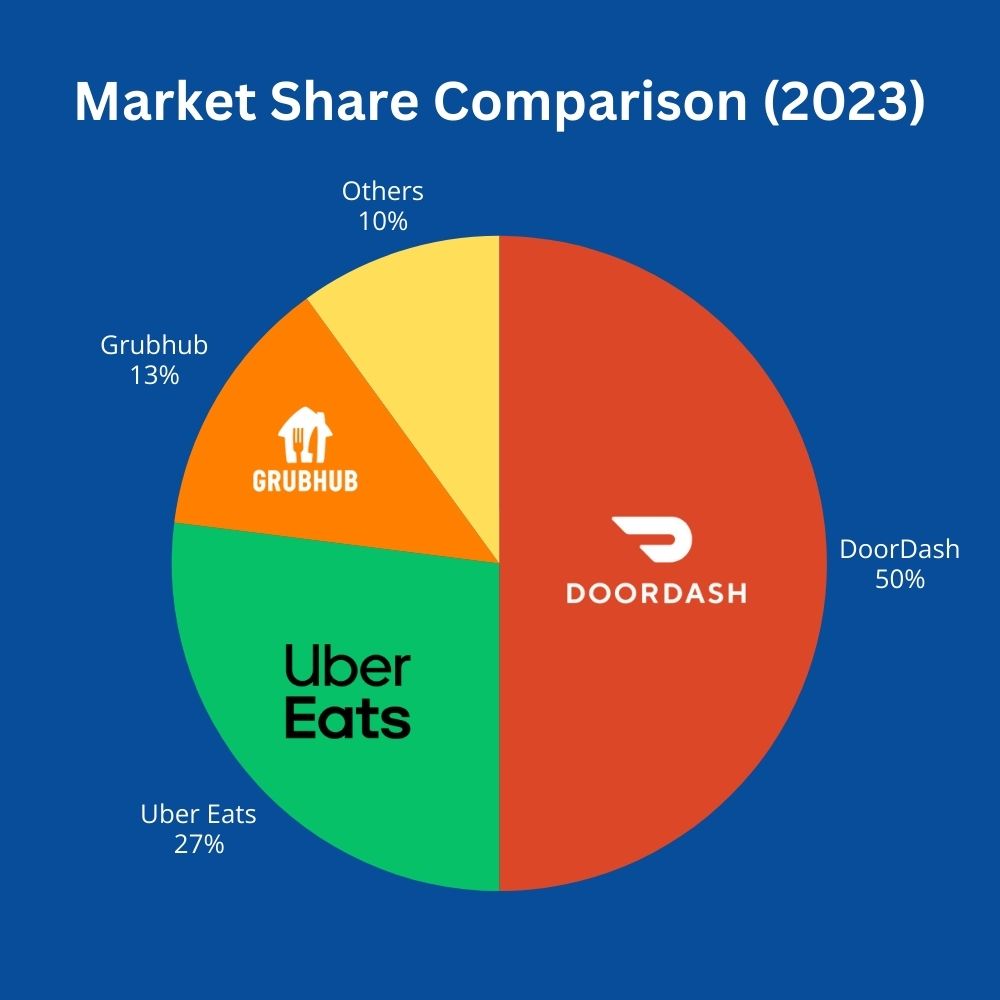
- The platform delivers more than 1 billion orders annually, solidifying its dominance.
- In 2022, DoorDash generated $8.6 billion in revenue, reflecting its strong operational and business model.
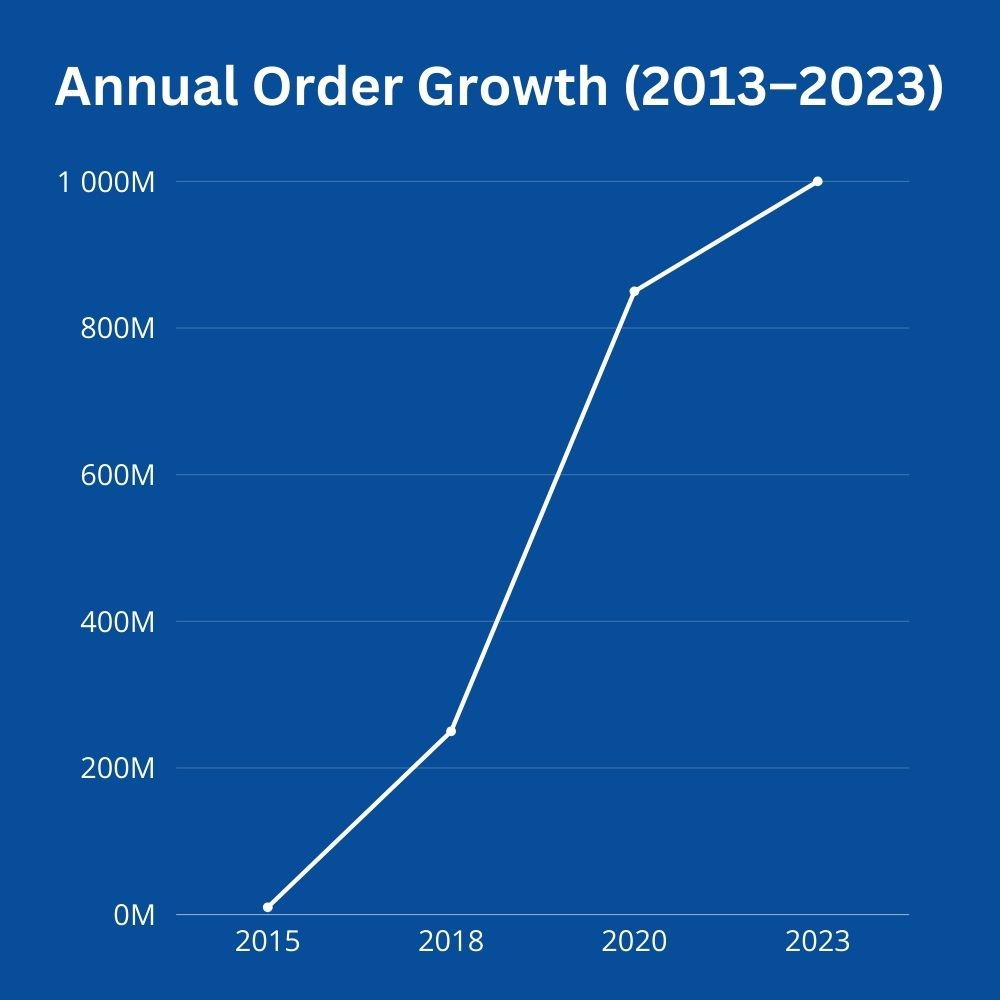
Lessons You Can Apply
Spot Opportunities Others Miss
DoorDash didn’t try to compete in crowded city markets initially—they carved their niche by focusing on underserved suburbs.
Prioritize Operational Efficiency
Reliable delivery systems make a huge difference. Customers stick with apps that offer fast, seamless experiences.
Partner for Growth
Small businesses are often overlooked, but DoorDash made them a cornerstone of their strategy. Build partnerships that add mutual value.
Scale Thoughtfully
Growth is good, but sustainable growth is better. DoorDash’s carefully planned expansion is a reminder that scaling too fast can hurt quality.
DoorDash’s story proves that with the right strategy and execution, even a small idea can become a billion-dollar empire.
Ready to build your own success story? It all starts with choosing the right food delivery app development services to bring your vision to life.
There are always some key players in every industry that shape the app for the best experience. Now, let’s look at what one successful food delivery app consists of!
Who Makes the Magic Happen in Food Delivery?
Behind every 5-star food delivery experience is a dynamic ecosystem of key players working together. From the person placing the order to the one delivering it, everyone has a role in making the process smooth and satisfying. Let’s meet the people who make it all possible:
The Customers
Whether it’s a late-night craving or a family dinner, customers are at the heart of the food delivery business. Did you know that 68% of millennials ordered food delivery in the past month? With convenience as their top priority, they’re the driving force behind this booming industry.
The Restaurants
From local eateries to big-name chains, restaurants fuel the food delivery engine. By partnering with delivery apps, they’re reaching new customers and boosting sales. In fact, restaurants report a 20-30% increase in revenue after joining food delivery platforms.
The Delivery Partners
These are the people who bring your favorite meals right to your doorstep. Apps like DoorDash rely on their vast networks—over 1 million delivery agents—to ensure orders arrive on time, every time. They’re the backbone of the delivery process.
The Admins/Business Owners
Behind the scenes, admins and business owners are orchestrating everything. They optimize operations, manage stakeholders, and ensure the app runs like a well-oiled machine. From streamlining logistics to enhancing the user experience, they keep the ecosystem thriving.
The seamless experience of ordering food isn’t just great for customers—it’s a lucrative business opportunity. Food delivery apps have mastered the art of generating revenue through multiple streams, creating a model that benefits all stakeholders.
How Food Delivery Apps Make Money
Commissions
Restaurants pay a percentage of every order placed through the app, usually 15-30%. It’s a win-win: restaurants expand their reach, and apps secure a steady income.
Delivery Fees
When you pay a small delivery fee—anywhere between $1.99 to $7.99—you’re contributing to the app’s operational costs while supporting the drivers who bring your food to your doorstep.
Subscriptions
Subscription plans, like Uber Eats Pass, are a game-changer. For a flat fee, subscribers enjoy perks like free deliveries and exclusive discounts, and in return, apps enjoy a 15% boost in revenue from loyal customers.
Advertisements
Ever noticed certain restaurants popping up at the top of your app? That’s no coincidence. Many platforms offer “sponsored listings,” where restaurants pay for better visibility, turning the app’s interface into valuable advertising real estate.
White Label Solutions
For tech-savvy entrepreneurs, some apps license their software so others can launch their own delivery platforms. It’s like giving startups a shortcut to success while earning a nice fee for the technology.
These revenue streams make food delivery apps more than just middlemen—they’re versatile platforms that cater to customers, support local businesses, and innovate for future growth. It’s a business model that feeds everyone, in more ways than one.
You’ve seen the success stories, understood the business models, and explored revenue streams. Now, let’s get down to the exciting part—creating your own food delivery app. It’s not just about coding an app; it’s about building a solution that stands out and serves real needs. Here’s how to make it happen:
Ready to Build Your Food Delivery App? Here’s How!
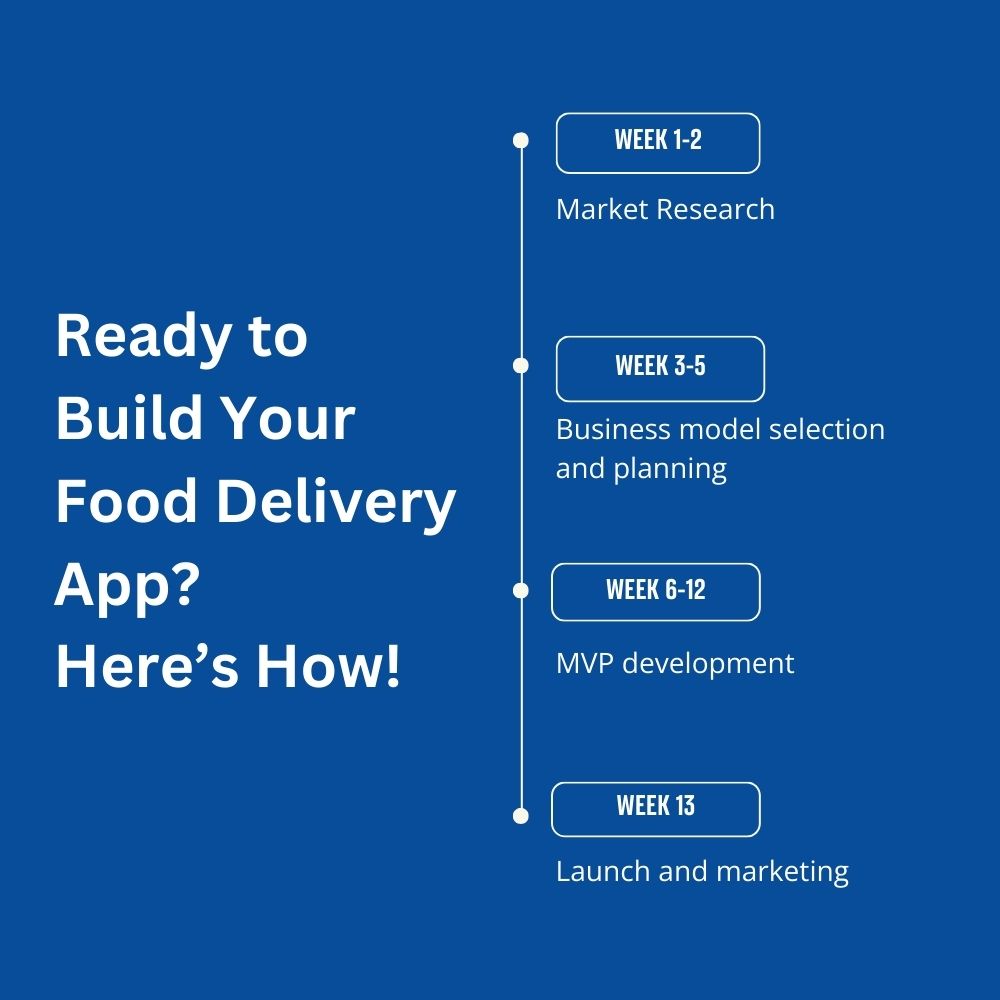
Start with Market Research
Every great app begins with understanding the audience. Research your target market to identify what’s missing. For example, DoorDash thrived by focusing on suburban areas, an underserved market at the time. Whether it’s a hyper-local niche or a unique feature, find your competitive edge.
Pick the Right Business Model
Think of this as the foundation of your app. Do you want to connect customers and restaurants (aggregator model)? Or manage deliveries end-to-end (logistics model)? Each option comes with its own opportunities and challenges—choose wisely based on your resources and goals.
Build Smart with an MVP
Don’t try to create a fully-loaded app right away. Focus on a Minimum Viable Product (MVP) that includes essential features like restaurant listings, easy ordering, and delivery tracking. Use this version to test the waters and gather feedback before expanding.
Launch and Market Strategically
A big launch isn’t always the best approach. Start small, focus on local promotions, and create buzz within your community. Collaborate with local restaurants, offer attractive discounts, and leverage social media to gain traction.
The Challenges of Food Delivery (And How to Overcome Them)
Building a food delivery app is no small feat. While the opportunities are vast, so are the challenges. To succeed, you’ll need to navigate obstacles like competition, logistics, and customer retention. Here’s how to address them effectively:
Competition
With established players like Uber Eats and DoorDash leading the market, standing out can feel daunting. Differentiation is key. Focus on what makes your app unique—whether it’s offering niche services, partnering with local restaurants, or providing an exceptional user experience.
Logistics
Managing peak-hour demand, ensuring timely deliveries, and minimizing order errors are some of the toughest challenges. Customers expect efficiency and accuracy, and your logistics system needs to deliver.
Tip: Invest in smart technology for real-time tracking, route optimization, and seamless communication between delivery partners and customers.
Customer Retention
Attracting customers is one thing; keeping them engaged is another. With so many apps offering discounts and deals, loyalty can be hard to maintain.
Tip: Implement loyalty programs that reward frequent users with discounts, free deliveries, or exclusive offers. Personalizing user experiences can also go a long way in building lasting relationships.
Concluding the Food Delivery App Development Guide
You’ve explored the ins and outs of building a successful food delivery app—everything from choosing the right business model to overcoming industry challenges. But here’s the big question: what will set your app apart? Whether you’re inspired by DoorDash’s hyper-local strategy or Uber Eats’ global ambition, success comes down to one thing: turning vision into reality with the right approach.
The journey doesn’t have to be overwhelming. With an experienced food delivery app development company by your side, you can create an app that’s not just functional but exceptional. From brainstorming innovative features to perfecting the final product, expert food delivery app development services ensure you’re set up for success.
Your dream app deserves the best, and with advanced Mobile App Development Services, you can deliver a seamless, engaging experience that keeps customers coming back.
Build Your App with a Leading Food Delivery App Development Company
Every great app starts with a bold step forward. If you’re ready to take yours, we’re here to help. Let’s build your dream app together! Contact us today, and let’s create something that redefines how people experience food delivery.
